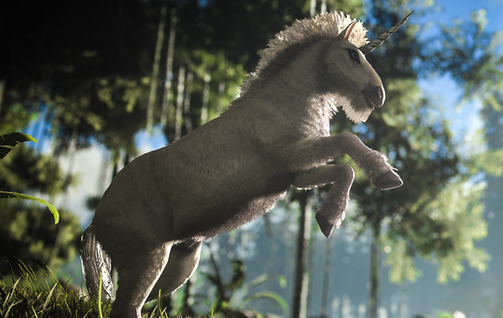Ark: Survival Evolved's design lead on huge server wipe reversal and new structure post-PC launch
'We're looking at $100,000 per month to [save] legacy servers; $100,000 to host new ones.'

Yesterday, I spoke to Studio Wildcard's co-founder Jeremy Stieglitz—who is also Ark: Survival Evolved's lead designer, lead programmer, and development director. The conversation was scheduled ahead of a pretty significant announcement he and his team had planned for today: that the open world survival 'em up planned to wipe its servers, a "mass extinction" as a pre-prepared statement suggested, ahead of its August 8 PC launch.
This morning, I was informed this was no longer the case, that Stieglitz and Studio Wildcard had made an equally significant 180-degree turn and that Ark would no longer undergo the proposed server wipe. A recent "rash of cheating and hacking" within the game had been billed as grounds for the move, however by rolling out a "fresh cluster network of servers running new code and infrastructure" will prevent similar issues occurring down the line.
Earlier today, I caught up with Stieglitz again to clarify the reversal. Stieglitz answered fully and, given the confusion tied to the relatively dramatic 180-turn, I've opted to publish his responses in full.

Jeremy Stieglitz is the co-founder of Studio Wildcard, and is the lead designer, lead programmer, and development director on the dev's seminal dinosaur survival adventure game Ark: Survival Evolved.
PC Gamer: So, in less than 24-hours Studio Wildcard has made a pretty explicit 180 regarding its decision, or lack thereof, to wipe its servers.
Jeremy Stieglitz: Welcome to Wildcard. So after speaking about our decision to wipe servers yesterday I went back and spoke to the team and asked: are we doing the right thing here? There are a lot of different opinions around the round table, so to speak, and we also talked to our community managers who are a little closer to the players than we are. And then, we also talked to our playtest team—the playtest team are actually like just players, they know the game really well, they're volunteers, they tend to take a look at our content, they're not employees so they come at it from an Ark fan standpoint more than anything else.
We also did another deep dive into the online debates about the wipe versus no wipe situation in Ark. Ultimately we took away from all that it just seemed like a pretty even split. You're talking about basically half the playerbase, even in PvP, that does not want to see this happen. It just doesn't seem like a good, smart move to, probably, piss off half the playerbase. We knew that before too, but we didn't have an exact statistic as such. We knew it was affect a lot of people, but the problem was that before we thought there was no way we could actually have this many servers. One thing we definitely didn't want to do, and we're definitely not doing, is we're not only having the old servers. They are seriously affected by this irreversible hack-a-thon.
It can be prevented going forward and they could maybe have recovered to some extent because the hacked items get used up through combat and conquest. But ultimately, we want players to have the option, new players especially, to experience the game as it's intended to be played. New servers are necessary and we figured that, even back before when we thought wiping was the only way to deal with this, we were determined that the cost and scope of hosting all the old servers and a good set of new servers which is beyond our means to do. What we found yesterday was that we took a hard look at what it'd take to support that and realised that we actually can do this. We can absorb the cost and scale of hosting the old servers and the new servers if we do a few things to ease our way into this process.
Keep up to date with the most important stories and the best deals, as picked by the PC Gamer team.
Number one: we need to take about ten percent of the servers down. Calling it
a 'no wipe' is somewhat inaccurate, it'll be a wipe of servers that nobody plays on anymore. I'm talking about servers that literally no one has played on in weeks, these are basically ghost towns. We don't know exactly what servers those are yet but it's literally servers that have no player population. By taking those servers down and doing that on a regular basis going forward—only those that have no player count over a sustained period of time. That may be no servers at some point if all the servers have people on them. If within a period of a few weeks these servers have people on them, that's what we'd consider an active server. This is something we communicated to the playerbase from day one—we discussed wipe versus no wipe plans, we said that servers that have no player population may be marked for obsolescence.

So, if we follow that through on a regular basis going forward, it becomes viable for us to not have an ever-increasing pool of servers in the long term. We feel that that is the kind of approach, at least on the legacy servers, that will enable us to have these legacy servers. Look, do we expect it to be a large portion of servers even in the long term that'll be marked for obsolescence? Unlikely, actually, if there's even one of two people playing on it in a month's time frame it's not our intention to take that down. This will be communicated in advance as we make these terminations in six month intervals so there will be some time.
By the way, this is different from an actual full wipe, because one of the things you can do in Ark is: if you server is, god forbid, marked for obsolescence, you can take your stuff, your character, your items, your gear, and actually travel to another server, refugee style. That's a mechanic that actually makes it not just like: hey, your progress is gone. That wouldn't have been possible if we had just wiped everything, but that's not what would ever happen. With this approach, when we actually ran the numbers and scaled it to our requirements we decided we can do it. It's costly for us, it's not a small investment of resources or time.
But we weighed the options and decided this is actually viable for us, it's absorbable for us, and this delivers on what we'd hoped to be able to do for our playerbase—our not insubstantial playerbase—this seemed like a good cost versus benefit calculation at this point. We ultimately did therefore reverse the thinking yesterday and that came about through some serious discussions. Ultimately it was kicked off by talking to [the press]. It was talking to the press, that made us think: Are we really sure about this? That in turn spurred me to go back to the dev team, talk to them about it again, and it just chained out from there until we ultimately came to the U-turn scenario.
Sometimes development is a pretty iterative process—sometimes we don't get it right first time. [Laughs] We're known for not getting it right first time, among other things. We maybe make a pretty fun game but we definitely don't have a 100 percent batting average, to say the least. That's human and okay, and I, at least in this case, think we didn't get the thinking right. Had we actually pulled the trigger on the gun? That wouldn't have been possible to un-shoot that bullet. There won't be as many new servers as old servers. We have around 400 PvP legacy server sessions and we're probably going to have around 200 new servers for this for the foreseeable future. Even then, the majority of our players would stay on legacy servers because that's where their homes are, so to speak. That's okay, because we'll also have a lot of new players coming in the door as we get to launch and beyond. We think there will be plenty to go round so far as player population but there won't be as many new servers as old servers.

On the face of it, you've reversed your decision overnight having spoken to the press, playtesters and your team. But surely you must have realised deciding against wiping the servers entirely was possible before now. Why did this decision go down to the wire?
To be blunt, it's a pretty large expense, we're basically looking at $100,000 per month additional to host the legacy servers, in addition to the $100,000 it costs a month to host the new servers. This is something we can afford as a successful company but it's expensive and it's non-trivial. It's not even just that, obviously the cost calculations are cold, cynical calculations—it's more than that, it's also about people in personnel, it takes manpower to host these servers. There are people who maintain them, upgrade them, keep them operating, fix problems on them when they inevitably occur. Those people who manage those servers are also part of our core development team. When they found out they have to manage, nearly, double the number of servers, they kind of flipped a shit. That's just human nature, they were like: great, now I have double the work forever.
Now, how do we deal with that? Well, we hire more help, basically, that's the answer to that. We also don't want to grow too much, too fast—that has its own problems. But I think the right time to grow if you're going to do it is when you launch retail. This was a combination of factors, there was also some technical scalability of our tools, of operating that amount of machines. We had to really think through the process and once we did, it's just on the right side of viable for us.
Could we have thought through that detail earlier? Certainly, sure. The difference is, sometimes you might chalk it up to laziness or flippancy but from a design standpoint you might say it's 'cleaner' for us to have less servers. From a design standpoint, then, when I think as a designer I think: well, we want to have a perfect game which lets none of the growing pains getting from A to B drag you down, so to speak. But as a player that's a different calculation—you're more emotionally attached, understandably and justifiably, to this world you've built. It doesn't matter about how much the abstract design might be benefited by cleaning everything up, you've put your effort into making this thing a reality. For someone to arbitrarily say: I just want to wipe that off the map, that doesn't make you feel good, no matter what they tell you.
People play games for emotional reasons, they play games to have fun. If you think about that from that perspective it makes sense. As far as why we didn't think of that earlier—we were maybe to focused on the abstracts of design, not enough on the needs of the playerbase. It was the wrong call—there's no other way to say it.

While I appreciate nothing is 100 percent certain and nothing can be guaranteed, given a server wipe was considered this time—can you reassure players that this won't happen down the line? What guarantees can you give players at this stage?
So long as I'm at the company, I'll do everything I can to prevent that from happening. It's hard to predict, for example, will Wildcard always be around? Hopefully, but short of it being the company that I'm at, that I have any influence over, it's important to me. I wouldn't want to see what sort of hell was unleashed, should these worlds that people have built disappear. I don't think it'd be pretty.
That's about as extreme as I can say: I think it would mean the end of what Ark is in its current form for that to happen. I think that would be very bad for all involved. I think, short of something very extreme happening to the company, it's certainly not in the game plan for any live operational status for Ark: Survival Evolved.
Part of the thing about Ark is it's not a standard MMO where you grind out loot, it's a creative game. People build structures, draw paintings, breed dinosaurs, they paint them too—you do all these things, you'll spend all this creative output inside the game world, that's kind of irreplaceable. Until someone destroys it in the PvP environment, of course.
Ark: Survival Evolved's full PC launch is due August 8.

